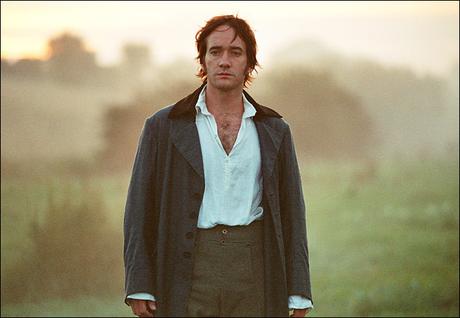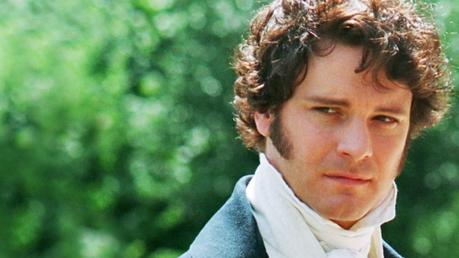
One of the greatest characters ever written, who happens to have a great name: Mr. Darcy.
" data-orig-size="650,450" sizes="(max-width: 650px) 100vw, 650px" data-image-title="Mr.Darcy" data-orig-file="https://stephsscribe.files.wordpress.com/2012/10/mr-darcy.jpg?w=720" aperture="aperture" />Mr. Darcy, played by Matthew Macfadyen.Mr. Darcy, Jane Austen’s proud, authentic, romantic hero of the novel Pride and Prejudice, remains, in my humble opinion, the best male character in romantic literature. I never tire of Mr. Darcy—of how he enters the novel full of pompous righteousness, and ends the novel being a character readers adore—because he begins to see the world, the class structure of people, and people in general in a whole new light as the novel unfolds. At the age of 28, Mr. Darcy begins to grow up and come into his own.
Pride and Prejudice is one of my two all-time favorite books (the other being A Christmas Carol by Charles Dickens). I can read Pride and Prejudice over and over, and am always amazed at the ease with which Jane Austen’s story evolves, evokes the sentiments of that time period perfectly, and keeps us giggling all the way through at some of the noteworthy characters that she incorporates into the overall love story between Miss Elizabeth Bennet and Mr. Darcy.

Because of my love for this novel, today I’ve compiled my own list of 5 lessons Mr. Darcy teaches us, and why Mr. Darcy is a character that helps inspire some of my own characters I write in my novels. So, here we go…
Number 1: Mr. Darcy epitomizes the notion that we shouldn’t judge people too hastily until we get to know them and understand their stories. Austen does a great job in her novel to make Mr. Darcy someone who may appear to be somewhat unreachable. Because of his wealth and stature, he has an air about him that people see as “stand-offish,” and so he does not interact well in social settings, keeping him in readers’ minds as off-limits. As the novel is told from Elizabeth’s perspective, we see him only as she sees him, which we learn later, may be somewhat unfair as she misjudges him. Nevertheless, he is a man who is so wealthy that people do not know quite what to make of him in the early pages of the novel. Darcy, who is called “disagreeable,” is capable of great depth of love and care. Darcy epitomizes the expression don’t judge a book by its cover.
Number 2: Mr. Darcy proves that marrying for love is the only way to go. Sure, Elizabeth is technically “beneath” him in class and stature, but once Darcy falls in love with Elizabeth, he throws caution to the wind and realizes that his happiness is not tied to how much wealth Elizabeth brings to the marriage or that her family is not on even footing in terms of social status. Mr. Darcy loves Elizabeth “most ardently,” and hopes that she loves him, regardless of how much money he has as well. Darcy teaches us commitment and that love is what matters, after all.
Number 3: Mr. Darcy shows initiative to fix a misunderstanding and apologizes when he is wrong. First, Mr. Darcy addresses a letter to Elizabeth clarifying the misconceptions she has about his relationship with Wickham, the books’ antagonist, and sets out to tell his version of the story, which is much different from that of Wickham’s account. Darcy fully explains the circumstances in detail, which leaves Elizabeth feeling badly about her defense of Wickham. Second, Darcy apologies in the letter about his interference with his friend, Mr. Bingley, and Jane, Elizabeth’s sister, honestly admitting that due to Jane’s shy personality, he discouraged the courtship because he found her “indifferent.” Darcy teaches us to take responsibility and apologize immediately for our actions when we have done something that may not be right.
Number 4: Mr. Darcy does anything he can to help, especially when he feels somewhat responsible for other people’s behavior. When Darcy finds out that Wickham has run away with Elizabeth’s sister, Lydia, he sets out to make sure that Wickham does not harm the Bennet’s reputation as a family, and sees to the marriage, ultimately paying for it (and what some believe was almost a year’s income of 10,000 pounds). Darcy does this to save Elizabeth’s family’s good name—primarily because he loves her so genuinely and deeply and does not want her to suffer for the indiscretion. Darcy teaches us that sometimes we have to step in to help people to lessen the pain that could befall them.
Number 5: Mr. Darcy does not give up, and practices his communication, going from awkward to downright poetic. In the novel, we watch Darcy’s clumsy and awkward conversations within the book. He is not good at expressing himself, as he keeps to himself and speaks bluntly when addressed, and these retorts are not always to his advantage. However, throughout the novel, Darcy works to overcome his way of speaking and engaging, and begins to alter the ways in which he relates to others. This is when perceptions of him begin to change, especially the way in which Elizabeth sees him. He learns to work hard to make things right, especially between Elizabeth and himself, and even invites her aunt and uncle to spend time with him at Pemberley. Darcy teaches us that we must always work at communication to better enhance and sustain relationships.
I love reading Jane Austen, and especially love how she is able to fully dissect her characters. Through her wonderful writing, we were given one of the best male romantic heros—a character we can certainly learn from for all the ages.
*


